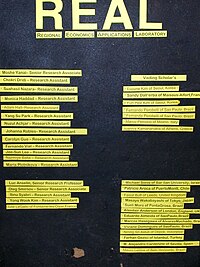Main goal
Created in 1989 by Philip Israilevich and Geoffrey J.D. Hewings, the Regional Economics Applications Laboratory (REAL) at the University of Illinois at Urbana-Champaign started as a cooperative venture between the Federal Reserve Bank of Chicago and the University of Illinois.
While analyses of economies at the national level have long been prominent in the field of economics, increasing fragmentation of the production process in conjunction with increasing regional specialization due to the reduction of transportation costs obliges us to consider economies from a sub-national or even local perspective. Further, the last decade has seen remarkable progress in techniques for spatial economic analysis – the measurement and interpretation of economic activity across geographies as small as counties to units as extensive as individual countries.
Based on these approaches and techniques, REAL’s mission is to provide timely, high quality analytical economic information for a variety of uses such as public policy decision making by public sector agencies and for strategic marketing in the private sector. REAL's capabilities revolve around comprehensive state and metropolitan models that integrate econometric and input-output analysis to provide for both impact and forecasting analyses. Current activities focus on interstate trade, forecasts for the Chicago, Illinois and other Midwest economies, housing market analysis and forecasts, demographic-economic modeling (especially the role of aging and immigration) and the development of alternative computable general equilibrium models created on the same data base.
Research at REAL always attempts to provide a range of exposure to new curricula materials, methods of conducting interdisciplinary and international collaborative research and guidance in the preparation of material for dissemination in the public policy arena. The latter component is extremely important and undervalued, yet academic research over the next decade is likely to be more project-driven with funding from stakeholders whose interest lie in the policy arena and less in the academic or scholarly content. Hence, it is important that scholars learn, at an early stage in their career, how to balance the needs of client-based research with demands imposed on them by the academy for demonstrating high levels of scholarly achievement.
REAL was created to operate like a science laboratory - with students and faculty together in one space, promoting interaction and collaboration. A weekly seminar series provides students with many opportunities to present their research and an active Discussion Paper series on the web ensures wide dissemination for research. REAL is supported by external grants and contracts, many of which have been developed with agencies in Brazil, Chile, Colombia, Indonesia, Japan, Korea, and Austria. Most of the research has successfully served two markets - academic journals and public policy.
Student involvement
Since its inception, REAL has provided at least two years (and usually more) support for 38 doctoral students from agricultural economics, economics, geography and urban and regional planning, welcomed 8 "bolsa sandwiche" PhD students from Brazil who spent one year at REAL working on their doctoral dissertations and hosted over 100 international visitors (visiting students, visiting scholars and visiting professors) who stayed three months or more. Several experiences of foreign scholars coming informally to the University of Illinois at Urbana-Champaign demonstrated that a period of one or two semesters resulted in a major contribution to the thesis of these young researchers, as well as to their personal enhancement. At any one time, from 15 to 30 visitors and students will be in residence. An updated list of past and current members is available from the following link: http://www.real.uiuc.edu/
Foreign visitors appreciate more especially the exposure to the challenges, issues and opportunities in another country because it provides them an important perspective that cannot be “taught” effectively by distance learning. Residence in another country, coupled with engagement with other students and faculty involved in their work provide them with an invaluable learning opportunity. In addition, the mass of students and the profound respect of REAL’s director for the various techniques of regional science allow foreign visitors to build quickly partnerships for their work and receive sound feedback.
Over the years, several colleagues, such as Rodney Jensen (Australia), Michael Sonis (Israel), Eduardo Haddad (Brazil), Joaquim Guilhoto (Brazil), Carlos Azzoni (Brazil), Miguel Marquez (Spain), Julian Ramajo (Spain) and Nikolaos Kalyviotis (Greece) have become regular visitors. The collaboration with Sonis has yielded over 75 publications (including two edited monographs and 24 book chapters). About one third of REAL's alumni are working in academia, another third in local, state and international agencies and the remaining third in the private sector.
The sister organization of REAL is EU-REAL , the European Union – Regional Economics Applications Laboratory. EU-REAL is a research net in regional science integrated by European scholars tied to REAL. Their goal is to foment the cooperation of their different members, establish permanent linkage among the participant researchers, and promote the development of different investigation lines in regional science.
An economist is a professional and practitioner in the social science discipline of economics.
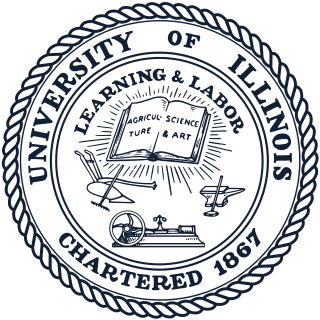
The University of Illinois System is a system of public universities in Illinois consisting of three universities: Chicago, Springfield, and Urbana-Champaign. Across its three universities, the University of Illinois System enrolls more than 94,000 students. It had an operating budget of $7.18 billion in 2021.

The University of Illinois Urbana-Champaign is a public land-grant research university in Illinois in the twin cities of Champaign and Urbana. It is the flagship institution of the University of Illinois system and was founded in 1867. Enrolling over 56,000 undergraduate and graduate students, the University of Illinois is one of the largest public universities by enrollment in the country.

The Beckman Institute for Advanced Science and Technology is a unit of the University of Illinois Urbana-Champaign dedicated to interdisciplinary research. A gift from scientist, businessman, and philanthropist Arnold O. Beckman (1900–2004) and his wife Mabel (1900–1989) led to the building of the Institute which opened in 1989. It is one of five institutions which receive support from the Arnold and Mabel Beckman Foundation on an ongoing basis. Current research at Beckman involves the areas of molecular engineering, intelligent systems, and imaging science. Researchers in these areas work across traditional academic boundaries in scientific projects that can lead to the development of real-world applications in medicine, industry, electronics, and human health across the lifespan.
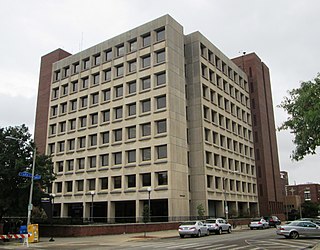
The College of Liberal Arts and Sciences (LAS) is the largest college of the University of Illinois Urbana-Champaign. The college was established in 1913 through the merger of the College of Literature and Arts and the College of Science. The college offers seventy undergraduate majors, as well as master's and Ph.D. programs. As of 2020, there are nearly 12,000 undergraduate students and 2,500 graduate students attending the College of Liberal Arts and Sciences.
Werner Baer was an American economist at the University of Illinois Urbana-Champaign and the Jorge Lemann Professor of Economics. He received his bachelor's degree from CUNY Queens College in 1953, and a Master's and a Ph.D. from Harvard University in 1955 and 1958 respectively. His research centered on Latin America's industrialization and economic development, especially of Import Substitution Industrialization (ISI) and Brazil.
Marianne A. Ferber was an American feminist economist and the author of many books and articles on the subject of women's work, the family, and the construction of gender. She held a Ph.D. from the University of Chicago.
Milton Feng co-created the first transistor laser, working with Nick Holonyak in 2004. The paper discussing their work was voted in 2006 as one of the five most important papers published by the American Institute of Physics since its founding 75 years ago. In addition to the invention of transistor laser, he is also well known for inventions of other "major breakthrough" devices, including the world's fastest transistor and light-emitting transistor (LET). As of May, 2009 he is a professor at the University of Illinois at Urbana–Champaign and holds the Nick Holonyak Jr. Endowed Chair Professorship.

Geoffrey J.D. Hewings is Professor of Geography and Regional Science, of Economics, of Urban and Regional Planning at the University of Illinois at Urbana-Champaign, United States. He is also the Director of the Regional Economics Applications Laboratory.
The Institute for Computing in Humanities, Arts, and Social Science (I-CHASS) at the University of Illinois at Urbana–Champaign was established in 2005 to conduct leading-edge research at the intersection of high performance computing and humanities, arts, and social science scholarship. I-CHASS is hosted by the National Center for Supercomputing Applications (NCSA) and maintains strategic partnerships with NCSA, the Great Lakes Consortium for Petascale Computation (GLCPC), and the Illinois Informatics Institute (I3). Through its work on identifying, creating, and adapting computational tools that accelerate research and education, it engages scholars from the University of Illinois and from across the globe to demonstrate approaches to next-generation interdisciplinary research with high performance computing.

The University of Illinois Laboratory High School, also known as Uni High or just Uni, was established in 1921 and is a laboratory school located on the engineering section of the University of Illinois campus in Urbana, Illinois. Its enrollment is approximately 300 students, spanning five years. The school is notable for the achievements of its alumni, including three Nobel laureates and a Pulitzer Prize winner. In 2022, Uni High was named as a top 15 public school in Illinois by Niche and the following year rose to a top 15 public school in the nation. In 2006 and 2008 it was recognized as a "public elite" school by Newsweek because of its students' high scores on the SAT. Before the change in the SAT's format in 2016, the average SAT score was 2045, and now varies from 1400 to 1600. As of 2019, the average SAT was a 1470. The average ACT score is a 32.

Alexandre Antônio Tombini is a Brazilian economist. He was President of the Central Bank of Brazil until June 13, 2016, when he was replaced by Ilan Goldfajn. Since September 2019 he is Chief Representative for the Americas, based in Mexico City, of the Bank for International Settlements (BIS).

Rashid Bashir is Dean of The Grainger College of Engineering, Grainger Distinguished Chair in Engineering and Professor of Bioengineering, at the University of Illinois at Urbana-Champaign. He was the Executive Associate Dean and Chief Diversity Officer at the Carle-Illinois College of Medicine at UIUC. Previously, he was the Abel Bliss Professor of Engineering, Head of Department of Bioengineering, Director of the Micro and Nanotechnology Laboratory, and Co-Director of the campus-wide Center for Nanoscale Science and Technology, a "collaboratory" aimed at facilitating center grants and large initiatives around campus in the area of nanotechnology. Prior to joining UIUC, he was at Purdue University from 1998–2007 with faculty appointments in Electrical and Computer Engineering, and Bioengineering. From 1992 to 1998 he worked at National Semiconductor Corporation in Santa Clara, CA as Sr. Engineering Manager. He graduated with a PhD in Electrical Engineering from Purdue University in 1992. He has authored or co-authored over 240 journal papers, over 200 conference papers and conference abstracts, and over 120 invited talks, and has been granted 50 patents. He is an NSF Faculty Early Career Award winner and the 2012 IEEE EMBS Technical Achievement Award. He received the Pritzker Lecture Award from BMES in 2018. He is a fellow of IEEE, AIMBE, AAAS, BMES, RSC, APS, and NAI.
Catherine "Cathy" J. Murphy is an American chemist and materials scientist, and is the Larry Faulkner Professor of Chemistry at the University of Illinois at Urbana-Champaign (UIUC). The first woman to serve as the Head of the Department of Chemistry at UIUC, Murphy is known for her work on nanomaterials, specifically the seed-mediated synthesis of gold nanorods of controlled aspect ratio. She is a member of the American Association for the Advancement of Science, National Academy of Sciences, and the American Academy of Arts and Sciences in 2019.
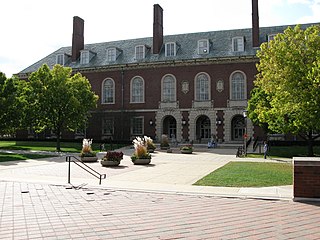
The University Library at the University of Illinois Urbana–Champaign is the network of libraries, including both physical and virtual library spaces, which serves the university's students, faculty, and staff, as well as scholars and researchers worldwide. The University Library continues to evolve to serve the needs of the University of Illinois at Urbana–Champaign campus.

The history of the University of Illinois Urbana-Champaign dates back to 1862. U of I is a public research-intensive university in the U.S. state of Illinois. A land-grant university, it is the flagship campus of the University of Illinois system. The University of Illinois Urbana-Champaign opened on March 2, 1868, and is the second oldest public university in the state, and is a founding member of the Big Ten Conference.
John R. Tucker was an American physicist who made several contributions to the fields of electronics, physics and microwave theory, known for generalizing the microwave mixer theory and presenting the body of work, known as the "Tucker theory", and for his fundamental theoretical contributions which resulted into various advancements in experimental Submillimeter astronomy. He is also credited with laying down some of the technological foundations for making practical Quantum computing possible.
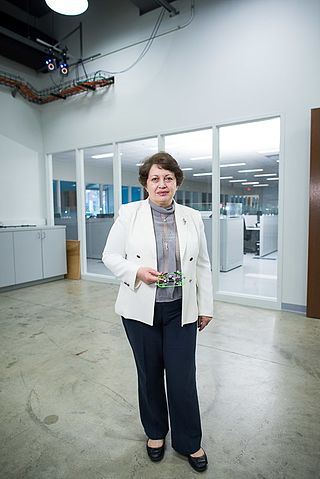
Naira Hovakimyan is an Armenian control theorist who holds the W. Grafton and Lillian B. Wilkins professorship of the Mechanical Science and Engineering at the University of Illinois at Urbana-Champaign. She is the director of AVIATE Center of flying cars at UIUC, funded through a NASA University Leadership Initiative. She was the inaugural director of the Intelligent Robotics Laboratory during 2015-2017, associated with the Coordinated Science Laboratory at the University of Illinois at Urbana-Champaign.
Andrew G. Alleyne is the Dean of the College of Science and Engineering at the University of Minnesota. He was previously the Ralph M. and Catherine V. Fisher Professor in Engineering and Director of the National Science Foundation Engineering Research Center on Power Optimization of Electro Thermal Systems at the University of Illinois Urbana-Champaign. His work considers decision making in complex physical systems. He is a fellow of the American Society of Mechanical Engineers, Institute of Electrical and Electronics Engineers, and the American Association for the Advancement of Science.
Xiuling Li is an distinguished electrical and computer engineering professor in the field of nanostructured semiconductor devices. She is currently the Temple Foundation Endowed Professorship No. 3 in Electrical and Computer Engineering and Fellow of the Dow Professor in Chemistry at the University of Texas at Austin. Previously, she was a Donald Biggar Willet Professor in Electrical and Computer Engineering and Interim Director of the Nick Holonyak Jr. Micro and Nanotechnology Laboratory at the University of Illinois at Urbana-Champaign.
